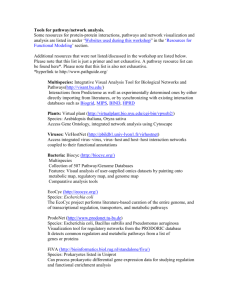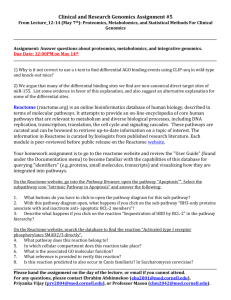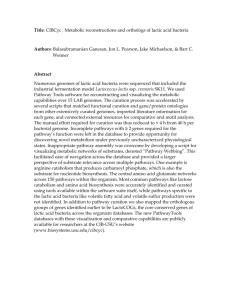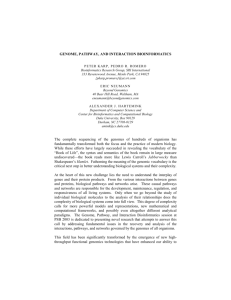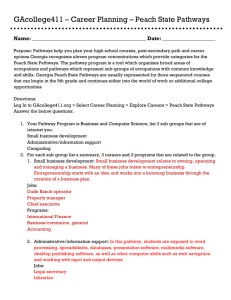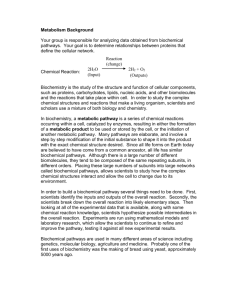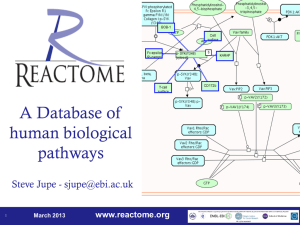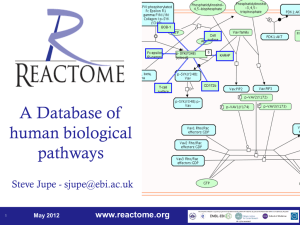Microbial biotechnology
advertisement
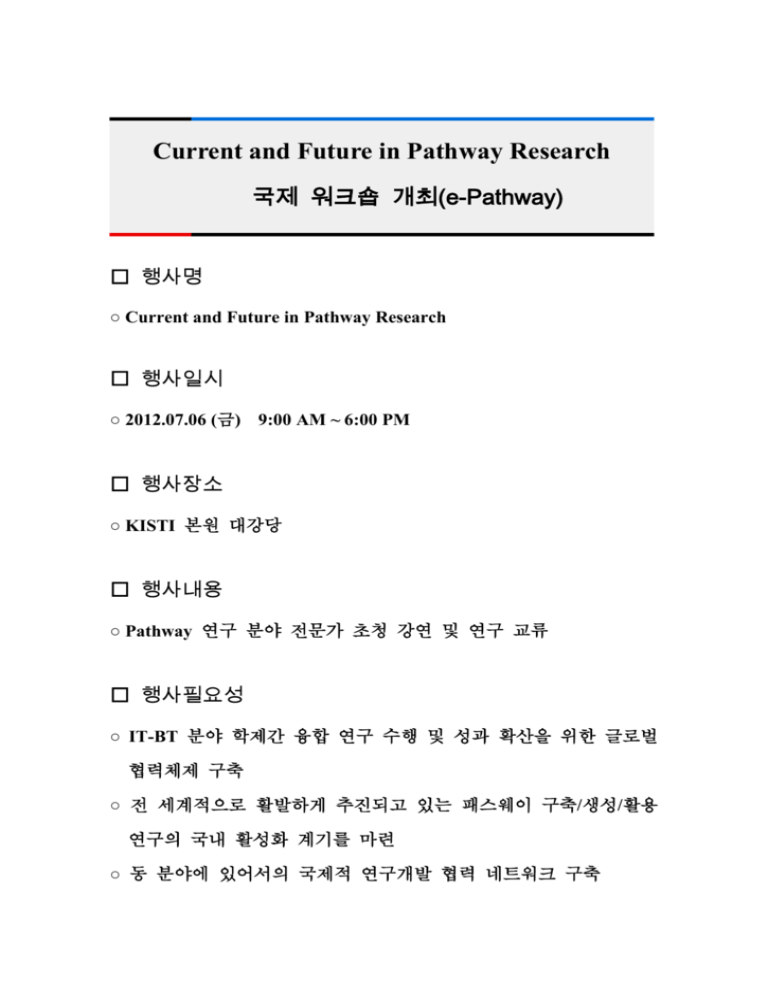
Current and Future in Pathway Research 국제 워크숍 개최(e-Pathway) � 행사명 ○ Current and Future in Pathway Research � 행사일시 ○ 2012.07.06 (금) 9:00 AM ~ 6:00 PM � 행사장소 ○ KISTI 본원 대강당 � 행사내용 ○ Pathway 연구 분야 전문가 초청 강연 및 연구 교류 � 행사필요성 ○ IT-BT 분야 학제간 융합 연구 수행 및 성과 확산을 위한 글로벌 협력체제 구축 ○ 전 세계적으로 활발하게 추진되고 있는 패스웨이 구축/생성/활용 연구의 국내 활성화 계기를 마련 ○ 동 분야에 있어서의 국제적 연구개발 협력 네트워크 구축 � 행사 프로그램 Time 9:30-9:50 10:00-10:40 Title Name & Affiliation Opening Won-Kyung Sung (KISTI) Linking pathways to literature: PathText Sophia Ananiadou (NaCTeM, Manchester Univ.) 10:40-11:20 Information in New Drug Discovery research Sung-eun Yoo (Choongnam Univ.) 11:20-12:00 The MetaCyc Family of Pathway/Genome Databases Ingrid Keseler (BioCyc, SRI) and the Pathway Tools Software 12:00-13:30 Lunch 13:30-14:10 e-Pathway: A Platform for the Autonomous Sung-Pil Choi (KISTI) Generation and I ntegration of Biological Pathway 14:10-14:50 Kousaku Okubo (DBCLS) 14:50-15:30 Systems Metabolic Engineering Sang Yup Lee (KAIST) 15:30-15:50 Coffee Break 15:50-16:30 KEGG: current status and its applications Goto (KEGG, Kyoto Univ.) 16:30-17:10 Reactome – Linking pathways, networks and disease. Robin Haw (Reactome) 17:10-17:30 Discussion & Closing Won-Kyung Sung (KISTI) 초청 연사 소개 및 발표 주제 Systems Metabolic Engineering Sang Yup Lee Department of Chemical and Biomolecular Engineering BioProcess Engineering Research Center and Bioinformatics Research Center Center for Systems and Synthetic Biotechnology, Institute for the BioCentury Korea Advanced Institute of Science and Technology (KAIST) Daejeon 305-701, Korea (leesy@kaist.ac.kr) There has recently been much interest in developing sustainable system for the production of chemicals, fuels, and materials from renewable resources. As microorganisms isolated from nature are often inefficient in performing our desired tasks, metabolic engineering is employed for the improvement of microbial performance. In this lecture, metabolic engineering based on quantitative pathway analysis will be presented with accompanying examples of producing chemicals, fuels and materials. Focus will be given on general strategies for systems metabolic engineering of microorganisms for successful bioprocess development. [Our work has been supported by the Technology Development Program to Solve Climate Changes from the Ministry of Education, Science and Technology.] Sang Yup Lee Sang Yup Lee received B.S. in Chem. E. from Seoul National University in 1986, and Ph.D. in Chem. E. from Northwestern University in 1991. Currently, he is Distinguished Professor and Dean of College of Life Science and Bioengineering at KAIST. He is also the Director of Center for Systems and Synthetic Biotechnology, Director of BioProcess Engineering Research Center, and Director of Bioinformatics Research Center. He has published more than 400 journal papers, and numerous patents. He received many awards, including the National Order of Merit, Citation Classic Award, Elmer Gaden Award, and Merck Metabolic Engineering Award. He is currently Fellow of AAAS, American Academy of Microbiology, Society for Industrial Microbiology and Biotechnology, Korean Academy of Science and Technology, and National Academy of Engineering of Korea. He is also Foreign Associate of National Academy of Engineering USA, Editor-in-Chief of Biotechnology Journal, and editor and board member of many journals. His research interests are metabolic engineering, systems and synthetic biology, and industrial biotechnology. Reactome – Linking pathways, networks and disease. Robin Haw Ontario Institute for Cancer Research, Informatics and Bio‐Computing, Toronto, ON, Canada The Reactome Knowledgebase of human biological pathways and processes is a curated and peer-reviewed knowledgebase available online as an open access resource that can be freely used and distributed by all members of the biological research community. Geneticists, genomics and proteomics researchers, clinicians, molecular biologists, bioinformaticians and systems biologists use Reactome to interpret high-throughput experimental datasets, to develop novel algorithms for data mining and visualization, and to build predictive models of normal and abnormal pathways. The Reactome curation system draws upon the expertise of independent researchers who author precise machine-readable descriptions of human pathways under the guidance of a team of curators. Pathway modules are extensively checked to ensure factual accuracy and compliance with the data model, and a system of evidence tracking ensures that all assertions are backed by the primary literature. Recent extensions of our data model accommodate the annotation of disease processes, allowing us to represent the altered biological behavior of mutant variants frequently found in cancer, and to describe the mode of action and specificity of anti-cancer therapeutics. Reactome pathways currently cover a quarter of the translated portion of the genome, and are available on our web site for browsing, downloading, and manipulation by in-house and third party online analysis tools. To increase protein coverage and associated annotations, we have extended our protein coverage by offering a network of “functional interactions” (FIs) predicted by a conservative machine-learning approach, that add an additional 25% of the translated genome, for a combined coverage of approximately 50%. We offer several analytical tools built upon the Reactome FI network and have begun to demonstrate the network’s usefulness for the analysis of genome-scale datasets in human disease research. Database URL: http://www.reactome.org Contact email: robin.haw@oicr.on.ca Information in New Drug Discovery research Sung-eun Yoo Department of New Drug Discovery Graduate School of Drug discovery & Development Chungnam National University Drug discovery is the process by which drugs are discovered or designed. At the beginning of early modern drug discovery era, numerous drugs have been discovered from traditional natural products or by serendipitous way. However over the years as our understanding of diseases has increased at the molecular and pathophysiological level, we now attempt to design the molecules in a logical way based on these informations. This logical process of drug discovery demands joint efforts between numerous scientific and technological disciplines classified generally as chemistry and biology. In order the new drug discovery process to be effective, communication and exchange of experimental information between these scientific disciplines become critical and crucial. In this talk, I will describe the general process of new drug discovery and emphasize the importance of exchanging informations between various scientific disciplines and particularly how the information from one discipline is translated into the other disciplines. KEGG: current status and its applications Susumu Goto Starting from 1995 with four core databases, PATHWAY, GENES, ENZYME and COMPOUND, KEGG has now 17 databases classified into three categories: Systems information, Genomic information and Chemical information. Despite the main objective of the KEGG system is to connect the genomic and chemical information through the systems information such as PATHWAY, BRITE, MODULE, the targets of KEGG are expanding to new research fields and general public including medical information for diseases and drugs. We also have to adopt to the new technologies. Recently metagenomics data from next generation sequencers have been accumulated and we have included some of the data in KEGG for the interpretation of the human gut microbiomes. Although manual curation is still a basis for the creation of reference pathways, modules, and functional hierarchies, many automatic processes have been incorporated into the functional annotation for complete genomes and metagenomes due to the exponential growth of genome sequences. In addition, tools for annotating genomes, predicting new pathways, and predicting genes for missing enzymes and functions have been developed as an application of KEGG and available on the web. The MetaCyc Family of Pathway/Genome Databases and the Pathway Tools Software Ingrid Keseler Senior Scientific Database Curator (EcoCyc) and Principal Investigator, BsubCyc project Comprehensive knowledge of metabolic pathways is required in a variety of biomedical and biotechnology applications. The MetaCyc family of Pathway/Genome Databases (PGDBs) describes the genomes and metabolic pathways of more than 1,700 organisms with sequenced genomes. These databases share a common schema and ontologies, facilitating interoperation and comparative analysis. Many are highly curated, including PGDBs for E. coli, yeast, mouse, and Arabidopsis. PGDBs in the MetaCyc family were derived computationally from MetaCyc. MetaCyc now contains more than 1,800 experimentally elucidated metabolic pathways found in more than 2,300 organisms. The MetaCyc data were curated from 35,000 publications. Pathway Tools, the software used to build, update and publish the MetaCyc family of PGDBs, contains a large suite of algorithms for manipulating biological networks and genome data. In particular, it includes inference modules for inferring the metabolic pathways of an organism, and for predicting genes encoding enzymes that might fill missing reactions in the predicted pathways. Recent additions to Pathway Tools include (a) the ability to generate steady-state metabolic flux models from PGDBs that enable prediction of the essential genes of an organism, and of its growth under different nutrient conditions; (b) a fast, accurate algorithm for prediction of reaction atom mappings; (c) tools for storage and analysis of organism growth data within PGDBs, such as Phenotype Microarray data. Linking pathways to literature: PathText Sophia Ananiadou full professor in Computer Science, School of Computer Science, University of Manchester and Director of the National Centre for Text Mining. PathText is a text mining based system linking models encoded in SBML with evidence from literature. The strengths of PathText include advanced search based on NaCTeM's text mining services, Facta+, KLEIO, MEDIE. These services include event extraction tools (EventMine), faceted search based on named entity recognition, disambiguation components and normalisation. In addition, our one-stop collaborative text processing workflow platform (Argo) includes annotation tools that facilitate curation of pathways. Issues on efficient querying and ranking from models will be addressed.
